Your Cart is Empty
Allergies: Tips and Advice

Some Allergy Statistics >>
What are dust mites and where do they live? >>
How do I stop dust mites? >>
What are the advantages of allergy bedding? >>
What do I need to protect myself? >>
What is the difference between membrane and non-membrane covers? >>
Will a mattress pad help? >>
How should I wash my bedding to reduce allergens? >>
Additional Tips for an Allergy-Free Room >>

Some Allergy Statistics:
- "Mite population and allergen levels decreased by 90% or more within a month of using mattress and pillow covers and treating bedding," according to a study from Johns Hopkins University.
- Over 40 million people in the United States are allergic to dust mites. If you suffer from allergies, you have an 80% chance of being allergic to dust mites.
- Mattresses are a hot spot for dust mites. A typical used mattress can become home to 100,000 to 10 million dust mites! To put into persprective, 10% of the weight of a two-year-old pillow can be attributed to dead dust mites and their wastes, according to a fact sheet from Ohio State University.
- Dust mites have negative effects on 60-80% of asthmatics.
- Each year, dust mites and other allergens, such as pet dander and mold, cause about 200,000 children with asthma to go to the emergency room, according to the US Environmental Protection Agency (EPA).
- Pet allergens affect over 10% of the US population and over 70% of all households contain a pet. Protect your bed from pet dander!
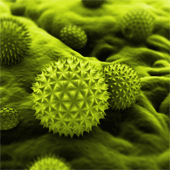
What are dust mites and where do they live?
Dust mites are tiny organisms that like to feed on mold spores and dead skin cells. These pesky allergens like to make themselves home in places with high humidity and warm settings, such as your mattress, pillows, and bedding. Within 10 years, dust mites and their waste can double the weight of your mattress! This can create an allergy nightmare. Common dust mite allergy symptoms include watery eyes, running nose, constant itching, and sneezing. To help control the amount of dust and allergens you breathe in, invest in allergen bedding.
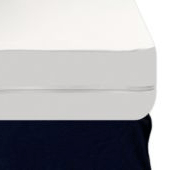
How do I stop dust mites?
Dust mites are a common allergy and asthma trigger for many people. You spend so much of your life in your bed, it is important to make it a safe and comfortable place to rest. First, encase all bedding (mattress, box spring, pillows, comforter) you can’t easily wash in a cover. All allergy relief covers must have a zipper and fully encase your bedding to be effective.
Wash all other bedding at least twice a month in HOT water (over 130 degrees) to kill dust mites. In your room, if possible, remove carpet and drapes which can harbor dust mites. If not possible, be sure to vacuum all carpet and drapes to remove as many dust mites and allergens as possible.
By following these few easy steps you can dramatically decrease the dust mites in your bedroom.

What are the advantages of allergy bedding?
Nearly 98% of allergists recommend protective bedding as the number one way to minimize indoor allergy symptoms, according to a Braun Research survey. And since we spend one-third of our life in our bedroom, it would make sense to invest in allergy bedding.
Allergy bedding protects us from dust mites, pet dander, etc. by encasing the entire bed, box springs, and pillow. This creates a barrier between you and the allergens. Decreasing exposure to household allergens will help reduce allergy symptoms and the chances of having an allergy or asthma attack. With allergy bedding, you will be sleeping in a healthier and cleaner environment. You won’t have to worry about having to wake up in the middle of the night with congestion and a stuffy nose. You can also take comfort in the fact that you won’t be living in a sea of dust mites and their wastes.
In addition to allergy protection, some dust mite bedding offer waterproof protection, keeping bodily fluids and moisture from ruining your mattress. Some allergy bedding can also provide bed bug protection. The Protective Bedding Store offers several types of allergy bedding, from vinyl encasements to non-membrane encasements. Whichever cover you choose, you can be rest assured that you are protected from dust mites and other allergens.
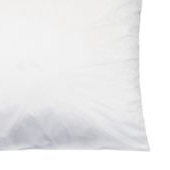
What do I need to protect myself?
You need a variety of products to protect yourself from harmful dust mites and allergens. First, you must cover your mattress. We offer 3 different types of encasements (for pillows, mattress encasements, and comforters) for you to choose from for your mattress:
- Allersoft: Consists of a tightly woven poly-cotton blend which allows air but no allergens to pass through. It looks and feels like fine cotton sheets. These covers do not protect against bedbugs or moisture.
- Premium Encasements: Similar to Allersoft, the premium covers have a terry-loop cloth top, but they provide waterproof protection on the top with a urethane membrane barrier and provide bedbug protection. The premium encasements are also breathable which makes them very comfortable. They are machine washable and dryable.
- Vinyl Encasements: Our most economical solution, this product comes only in mattress and pillow covers. For people with extreme allergies, the vinyl products do produce some odor in the beginning so be aware of that. They are not breathable, but they offer dust mite, bedbug, and moisture protection. While vinyl encasements are not our most comfortable solution, they are great for covering box springs.
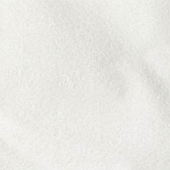
What is the difference between membrane and non-membrane covers?
Allergy relief covers are often classified into two categories: membrane and non-membrane. Membrane covers have a non-fabric barrier to protect against allergens. These types of covers are often waterproof and protect against bedbugs (all our membrane covers protect against both). They can sometimes be noisier and less comfortable than non-membrane covers. Our membrane covers with urethane barriers are quiet, comfortable, and offer the most protection.
Non-membrane covers consist of tightly woven fabric to protect against dust mites and allergens alone. They are considered the most comfortable due to their high breathability and light weight. Non-membrane covers do not protect against bedbugs or moisture.

Will a mattress pad help?
While a fitted mattress cover may offer some protection, it is not recommended for allergy relief because dust mites and allergies can still escape from under the edge of the cover. It can be good to put a mattress pad over your encasement and wash the pad more frequently, but a mattress pad will not provide you the same protection and benefits as an encasement.
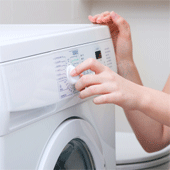
How should I wash my bedding to reduce allergens?
Dust mites love the warmth of your bed and bedding, so it’s important that you frequently wash your bedding to reduce the amount of allergens in your room.
All washable bedding, including pillow covers and mattress covers, should be washed in hot water (130+ degrees) and dried in high heat (tumble dry allergy mattress covers on low heat). Bedsheets, pillowcases and blankets need to be washed at least once a week. Pillow encasings should be washed every two weeks, while comforter and mattress encasings should be vacuumed every two weeks and washed 1-3 times a year.
Be sure to unzip the encasements before washing. Keep in mind that vinyl mattress protectors are not machine washable but can be wiped clean with disinfectant or soap and water. Membrane and non-membrane cloth encasements are machine washable and dryable. Never use bleach or fabric softener on your allergy bedding as this can damage the integrity of the bedding. Don’t forget to wash stuffed animals and toys!

Additional Tips for an Allergy-Free Room
In addition to using allergy bedding, here are several tips you can use for an allergen-free room:
- Mop or wipe down hard surfaces with a damp cloth every week.
- Use air conditioning instead of opening windows. This will help prevent pollen from coming into the room and filter the air that is already there.
- Replace old carpet with hardwood. If you don't want to replace your carpet, dust and vacuum rooms and furniture at least once or twice a week to prevent allergen buildup. Shampoo carpets at least once a year.
- Minimize stuffed animals or other soft toys in the bedroom. Opt for machine washable stuffed toys.
- Bathe and brush your pet at least once a week to minimize pet dander and hair.
- Clear clutter. This will reduce the amount of dust collected in the room.
- Change your air conditioner's filter frequently.
- Invest in a vacuum that has a HEPA filter. This will prevent dust and dirt from being recycled back into the air.
